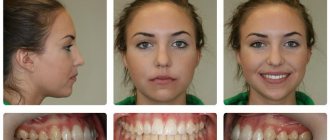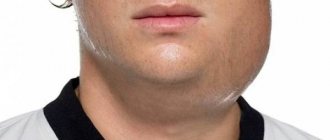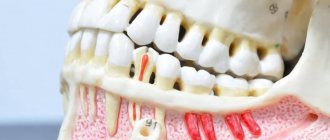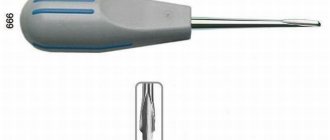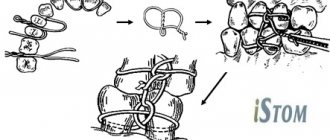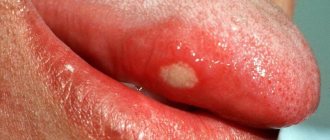Anatomy of the human jaw
The human maxillofacial region has the following anatomical structure:
- mouth slit,
- vestibule of the oral cavity,
- cheeks,
- lips,
- solid sky,
- soft sky,
- language,
- gums,
- teeth,
- upper and lower jaw.
The oral fissure is limited by the lips, which represent the orbicularis oris muscle and subcutaneous fat.
The cheeks are formed by adipose tissue (Bishat's lump) and bundles of buccal muscle. In the projection of the crown of the upper second molar on the inside of the cheeks there is a papillary elevation of the mucous membrane.
The excretory duct of the parotid salivary gland opens from the papillary eminence.
The oral cavity, cheeks, upper and lower gums and teeth form the vestibule of the oral cavity.
Gums are alveolar processes of the upper and lower jaws, covered with mucous membrane, which cover the teeth in the cervical area.
The mucous membrane of the mouth and the enamel of the teeth are constantly moistened with saliva, which is secreted by paired parotid, sublingual and submandibular glands, as well as many small glands, in a volume of up to 1.5 liters per day. Saliva contains organic and inorganic substances, it contains about 18 amino acids, 50 enzymes, mucin, substances with antibacterial activity (leukins, opsonins, lysozyme).
Saliva promotes the maturation of enamel, remineralization, has a cleansing effect, antibacterial activity and at the same time favors the formation of plaque and tartar.
The hard palate is formed by the palatine processes of the upper jaws and the perpendicular processes of the palatine bones.
The soft palate is formed by muscle fibers covered with a mucous membrane with a large number of mucous glands. On the sides of it there are arches - the palatine lingual and the velopharyngeal, between which there are accumulations of lymphoid tissue, the so-called palatine tonsil.
The tongue is a muscular organ covered with a mucous membrane. Its structure is divided into a wide rear part - root, body, middle part and apex. On the upper mucous membrane of the tongue, there are four types of papillae containing taste buds: filiform, leaf-shaped, mushroom-shaped, and rough.
Upper jaw
The upper jaw is a paired fixed bone. Its structure includes the body, palatine process, frontal process, zygomatic process, and alveolar process.
The palatine process takes part in the formation of the hard palate, the frontal process participates in the formation of the orbit, the alveolar process carries the sockets of the teeth - alveoli, and the zygomatic process attaches the zygomatic bone.
In the body of the upper jaw there is a cavity - the maxillary sinus, containing air and lined from the inside with mucous membrane. In close proximity to it are the apexes of the roots of the large molars (especially the sixth). Therefore, there is a high probability that the inflammatory process that has arisen in the tooth and periodontal tissues can easily spread to the sinus - sinusitis will develop.
Lower jaw
The lower jaw is an unpaired movable bone, shaped like a horseshoe. Its structure includes: a body with dental alveoli; two branches ending in condylar and coronoid processes; the condylar process, which connects with the articular fossa of the temporal bone, participates in the formation of the temporomandibular joint, due to which movement in the lower jaw is carried out.
According to data from dental reference books
A full range of dental services in Istra for adults and children: from consultation to complex operations within one clinic “Doctor Nebolit”
Consultation and appointments daily from 9:00 to 19:00
- +7 (49831) 4-42-12
- Contacts
The structure of the maxillary processes
The maxillary apparatus is formed by two paired bones.
They are divided into a body and four appendages:
- zygomatic;
- alveolar;
- frontal;
- pair of palatine processes.
The structure of the frontal process
The process starts from the maxillary base. In front it is attached to the nasal bone, the upper edge is adjacent to the nasal part of the frontal region of the face. The posterior part of the process is adjacent to the lacrimal ossicle.
The middle region of the process faces the inside of the nasal space. The middle turbinate is attached to it by the anterior edge. The anterior lacrimal crest runs along the sides of the frontal process, and the lacrimal groove runs nearby.
The structure of the zygomatic process
Adjacent to the upper edge of the body of the jaw, attached to the zygomatic bone. Exactly in the interval from the lower edge of the zygomatic process and the alveolar eminence belonging to the first painter lies the zygomaticalveolar ridge.
The main task is to redistribute the load during the process of chewing food and biting, so it is directed from the teeth to the zygomatic bone.
The structure of the palatine process
Palatine processes of the upper jaw, paired, symmetrical. Going from the right and left to the middle, they unite and form the anterior edge of the hard palate. Externally, they are thin, horizontally located bone plates.
They are attached to the alveolar process anteriorly and laterally. Their posterior part is fixed with the horizontal plate of the palatine bone.
The upward looking, smooth part of the palatine process of the maxilla faces the inside of the nasal space. The lower part, which is rougher, goes into the oral cavity. This zone, which has a large number of palatine grooves, is saturated with vessels, nerve fibers and pathways of the palatine glands. The largest groove is the one running along the bend of the alveolar formation.
A nasal ridge runs along the center of the nasal surface of the process, from the front part of which a bony outgrowth is formed - the anterior nasal spine.
The structure of the alveolar process
Alveolar ridge location
This process is a continuation of the body of the upper jaw. It is a bone structure curved in the shape of an arc. It consists of two halves, symmetrically located towards each other and connected in the center by an intermaxillary suture.
The maxillary alveolar structure includes alveoli, recesses. The roots of the teeth are located and firmly attached to them. There are eight alveoli in total, all of them are isolated from one another by a bony septum.
Holes are formed in the bottom surface to allow nerve fibers and the blood supply system to approach the teeth. These holes are also separated by bone plates. The shape, number and size of holes vary depending on the location and structure of the tooth.
Important: the shape of the holes also changes with a person’s age, during the development and change of teeth.
An alveolar elevation is formed for each alveolus; it can be felt through the gums at the roots of the teeth. The size of the alveolar elevation is influenced by the person’s age, the anatomical shape and size of his jaw and teeth, as well as the characteristics of the root system.
The formation of this bone structure occurs as a person grows and teeth erupt. During this time, its body thickens and increases significantly in size. First, giving the opportunity to grow baby teeth, and then permanent ones, the roots of which require a lot of space.
Important: sometimes dentists examine the alveolar eminence before removing a tooth; this manipulation provides information about the complexity of the upcoming procedure.
How to determine?
A distinctive characteristic is the tight contact of the upper and lower jaws when closing . The upper teeth are superimposed on a third of the lower crowns, leaving no distance between the upper and lower molars.
photo: this is what a correct bite looks like
The shape of the dentition and their relative sizes are also important. The top row has a semi-oval shape, the bottom row has a parabolic shape. The lower incisors are in contact with the palatal cusps of the upper ones. During chewing, the molars constantly touch without losing contact.
Correct bite forms a harmonious face , the lower and upper jaws are symmetrical, the vertical axis of symmetry of the face coincides with the junction line between the incisors.
Signs of a correct bite are also:
- no speech defects;
- comfortable biting and chewing of food;
- absence of uncomfortable sensations and clicking in the mandibular joint.
If you notice that plaque appears only on individual teeth, this means that they are not involved in the process of grinding food . In this case, it is worth visiting a dentist: this is a sign of a defectively formed dentition.
Injuries to the processes of the upper and lower jaw
Fractures of the upper jaw are a serious injury
Important: if a person receives head and face injuries, he should seek advice from a traumatologist as soon as possible in order to exclude the occurrence of complications; the cost of delays after accidents is very high.
The most common type of injury is fracture of bone structures. Based on the structural features of the processes of both jaws, their thinness, fractures in accidents and incidents are very common.
Injuries to the processes of the upper jaw
Important: for injuries of this type, it is very important to see a good specialist, because the doctor must determine the degree of the fracture and the volume of the broken area.
The maxillary alveoli are much more vulnerable to forceful impacts on the face than similar mandibular structures.
This happens for some reasons:
- the upper alveolar region is longer and thinner;
- the plates of the compact substance are saturated with holes for the access of blood vessels and nerves, this makes the bones more vulnerable;
- the alveoli of the lower jaw are protected from injury by the chin bone, which protrudes and takes the brunt of the blow;
- The maxillary alveoli are protected only by the zygomatic bone and arch.
The complexity of injuries to the maxillary alveoli is the displacement of fragments to the sides when broken off. It may be partially displaced to the sides; rarely, its total separation from the surrounding bone tissue is possible.
Important: for fractures of the upper jaw, the fracture line runs along the sutures of the bones.
Fractures of any part of the upper jaw are a very difficult case due to the close connection of all bone structures of the skull. Several bone structures of the face are broken off at once. In cases of extensive fractures, the base of the skull is often damaged.
Injuries to the processes of the lower jaw
Situations when the coronoid process breaks are not very common. This injury most often occurs with a strong blow to the chin area, directed from top to bottom. If the coronoid process is broken, then when the mouth is opened, the jaw will shift towards the injury. When palpated, severe pain is felt.
Important: with this injury, the maximum information content is shown by a lateral x-ray when the patient’s mouth is opened to the maximum.
The condylar process of the mandible often breaks as a consequence of a fracture of the maxillary ramus. In this case, the sections belonging to the process are damaged unevenly. The most vulnerable section is the base.
This area breaks due to a bend in the bone tissue. Injury occurs when the blow is directed to the side of the chin and the side of the base of the lower jaw. The situation will have the same outcome if the blow hits the side of the face and slightly below.
When the blow moves from the front or back, a fracture of the neck of the condylar process occurs. This situation is explained by differences in the density of bone structures.
